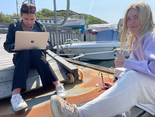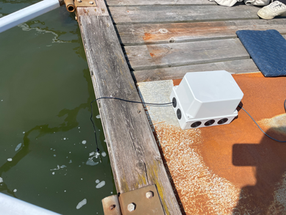Work Process
Extended version of all lab logs is found here

Week 1

Week 2
Week 3-4

Week 5
Week 6-7
Week 8



.jpg)

Tasks:
The tasks for this lab week were to get started on the project and understand the chosen industry, the boatyard industry. The group wanted to brainstorm different ideas for a sensor, consider potential interviewees and possible data collecting stakeholders. The first week also included a visit at the Chalmers Fuse lab to get a picture of which tools were provided and to get some inspiration for future workshops. Further it was the group’s hope to gain some knowledge about holding interviews through a coaching session.
Results:
In order to get started on the project the group made an inspiration board on paper with all sorts of ideas, including sensor names, possible interviewees and stakeholders. Some of the possible stakeholders that were discussed were municipalities, boat owners and suppliers to boatyards. It was also discussed how the interviews should be held according to PESTEL to get many different points of views. A draft email for boatyards was also commenced since the group considered it to be beneficial to have a complete email to send out quickly. Further, a version of a group contract was conducted for the sake of clarifying expectations from each other and the project. An insight we had during our lab session was that our sensor and project has to have an incentive to be used and the incentive could be economic benefits or to be able to market themselves as environmental. An idea about making a sensor connected to measuring barnacles on boats, and anti-fouling paint was planted during the research about the difficulties in the boatyard industry.
Tasks:
The team's task for the week included gaining more knowledge about building the sensor by visiting the Revere Lab, conducting interviews to gain insight into the boatyard industry and sensors, and contacting paint companies to discuss ideas about anti-fouling paint and related toxins. Further, the tasks were to contact more people for interviews as well as preparing and filming a pitch for the first pitch submission.
Results:
As a result of the group's interviews and research, the initial idea about a barnacle-sensor was adjusted to focus on measuring salinity levels. Valuable information from industry professionals was gained, including insights into the environmental impact of anti-fouling paint and the challenges faced by boatyards. The group meetings went smoothly, and valuable feedback from the group mentor was received. Additionally, a laboratory appointment was scheduled to continue the work on the sensor. During this lab week the name SALLY also came up as a suggestion for the sensor.
Tasks:
The team had a clear set of objectives for a lab session at the Fuse lab. It was planned that input from coaches would be seeked on how to build a salinity sensor and begin building it. Additionally, the group aimed to conduct interviews with paint color companies, researchers, boatyards, and the target group, boat clubs and marinas. To support the project, it was also a mission to make a logotype for the sensor. The group also started working on the industry deep dive and took a closer look at the industry and how the sensor can benefit it.
Results:
Possible interviewees from various PESTEL areas have been contacted and the group came up with ideas on what information should be strived to collect from the interviews. The research conducted on the materials needed for creating the sensor resulted in an idea for a conductivity-based sensor that can be converted to measure salinity through a program. Valuable insights on the industry were also gained, which answered questions related to government regulations, disruptive technologies and their impact on the industry. Technologies such as electric and hybrid propulsion systems, digital twin technology, advanced materials and autonomous technology are among the disruptive technologies that might influence the industry were researched. While starting on the logotype for the sensor, the website building was also commenced.
Tasks:
The objectives for this week were to search for some more interviewees in the different PESTEL areas as well as book appointments with the people which replied to the emails sent before. Further, the Revere lab was visited again to start building on the sensor and for this a prototype was also made in Tinkercad to get a picture of where the sensor would be located and how it could look. The work on the industry deep dive analysis was continued and parallel to this the second pitch presentation was initiated.
Results:
Interviews were conducted successfully and insightful information was provided on, for instance, the economic as well as technical perspective of boatyards. Some difficulties were encountered in finding the right people for each category for the PESTEL analysis but it was manageable. Some issues with the ADC-module for the sensor were faced, which were solved by increasing the budget and considering using an Arduino instead. There was also some consideration around making the sensor more aesthetically attractive but it was decided to focus on making it as practical as possible instead.
Tasks:
The two main tasks for the week were to start the construction of the sensor and progressing with the website layout by adding and writing content. The group is still waiting for the details they ordered for the sensor to arrive, but they have a plan in place. In addition to these tasks, the last interviews were conducted and all interviews were summarized to get a clear picture of all information that has been allocated from them. Further, the second pitch was going to be held this week which would give the group feedback on the project so far.
Results:
Some technical difficulties and problems with sound arose during the pitch. Despite this, some valuable feedback was received, which will be incorporated in the next pitch. The group managed to connect different parts of the sensor and install the necessary libraries. The group encountered a problem while welding parts to the ADC-module but managed to solve it by borrowing a pen to solder and watching YouTube videos. The interviews with industry experts were helpful and the process of compiling the interviews provided a structure for the group.
Tasks:
This week was about finalizing the project and therefore many different tasks were worked on to finish all of them. This included conducting some more interviews, doing further research for the industry deep dive, completing the logotype, discussing and making the layout for the webpage, making a pitch video and an instruction video for the sensor as well as finalizing the sensor and testing it to make sure it works.
Results:
Some challenges were encountered while trying to find specific information about the industry and how it is evolving technically. Further, insightful information about the legal and political aspects of the industry was given from the last interviews. There were some difficulties regarding the sensor programming and how the collected data would be uploaded to the webpage.However, all of the obstacles were surmountable by having productive group discussions to hear each other’s ideas, supporting each other within the group and addressing the problems as a team.
Tasks:
The objectives for this week were to finalize the sensor and test it in the ocean to make sure it is able to properly measure salinity in marine environments. Also while visiting the ocean, a big task was to document this process by taking many pictures and videos to use this for our pitch powerpoint and website. Further the data that was collected had to be on the webpage which meant that a mission was to figure out how to do this and display it how we wanted it to look. Additionally, the week was about completing the podcast, pitch video, sensor video, poster, gathering all sources used during the project and preparing for the big conference.
Results:
Although the last weeks were tough with many tasks to complete, it was manageable thanks to the whole group working many hours every day. The visit to the ocean went well and the data that was wished for was provided. The salinity data differed a little bit from the actual value, but this was expected. Further, the group managed to upload the data directly to the website and also display the time and place it was collected by doing a bit of research on how to make this happen. Further, the webpage was completed and is considered to be finished successfully. There is much information and it is divided into different ways of learning, both texts, videos, podcasts and pictures. The group is very satisfied with the project results and is now looking forward to the coastal data salinity challenge gap conference!



















